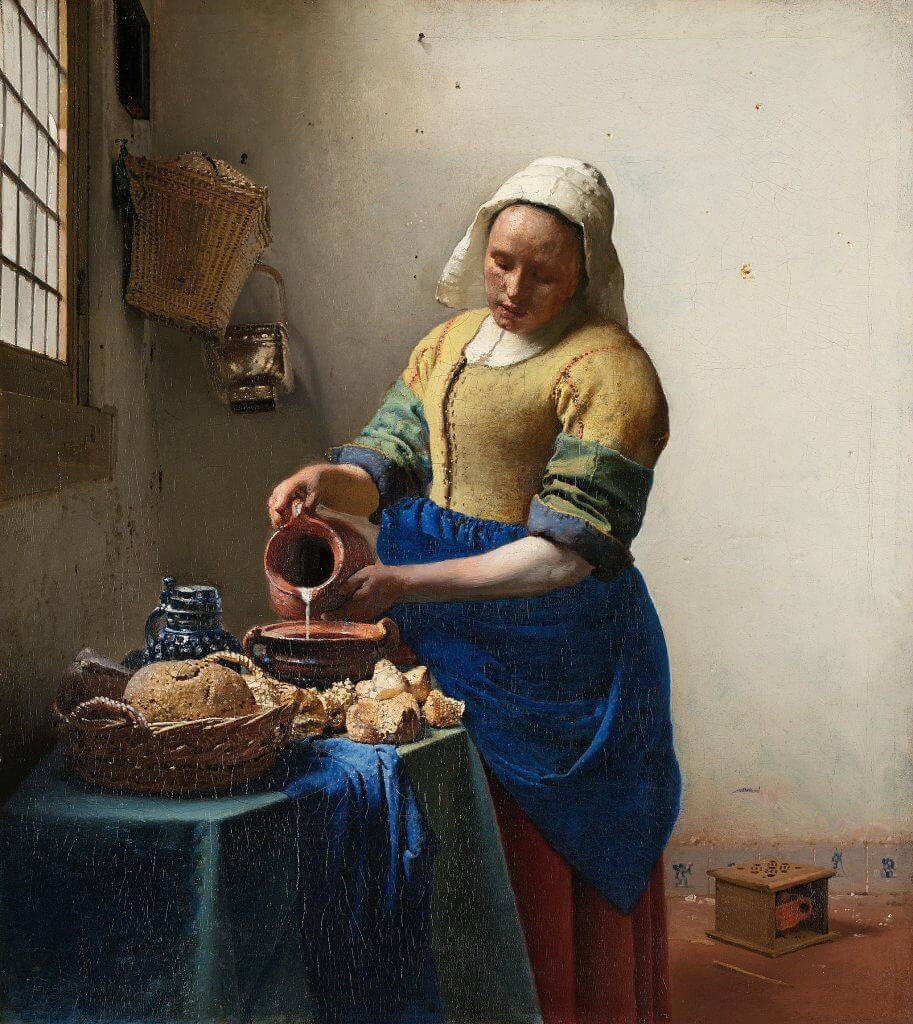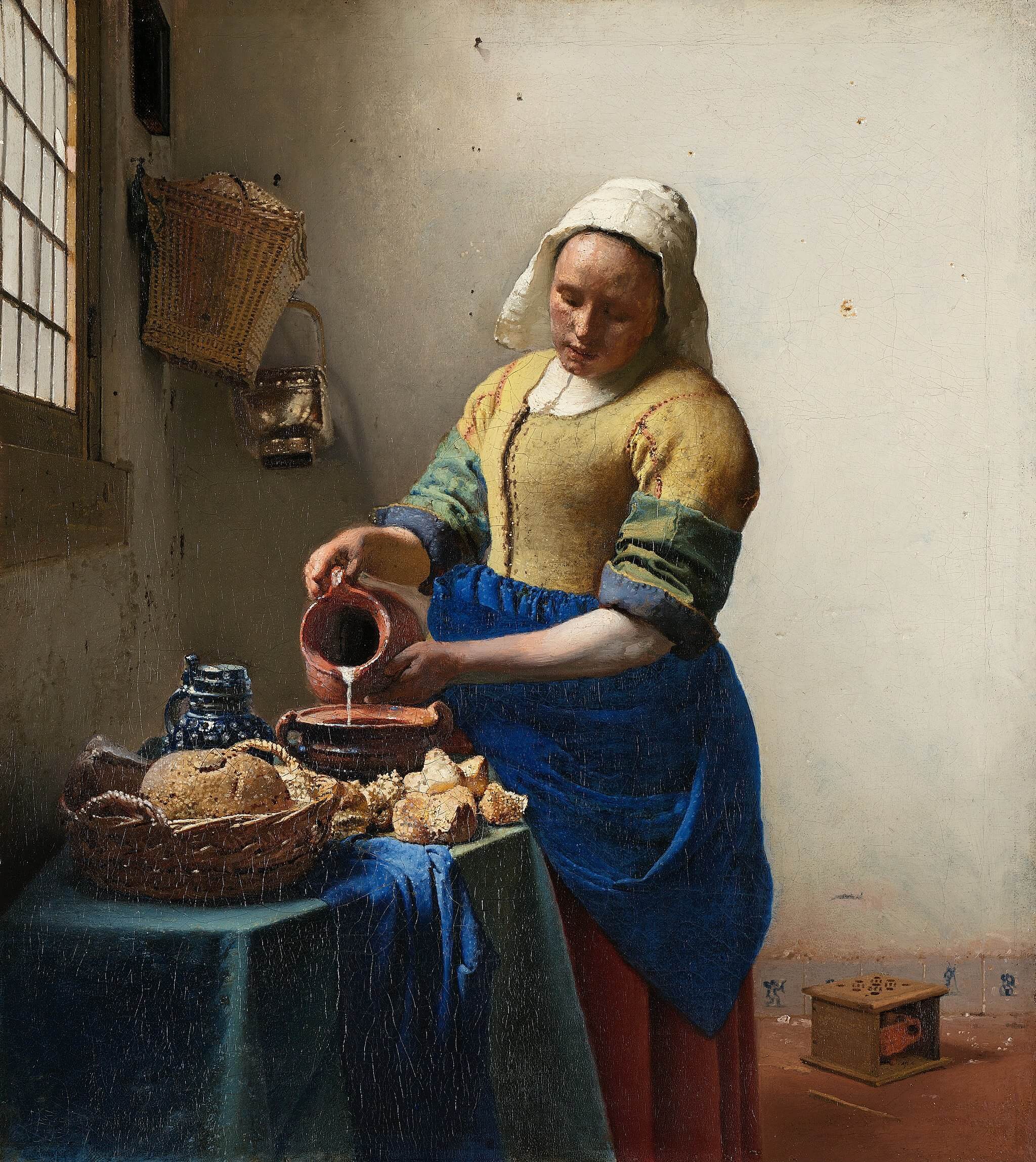Step into a world of nostalgia as we dive into the enduring image of The Milkmaid of Johannes Vermeer in art and literature. From the quaint countryside scenes of 17th-century Dutch painting to the romanticized depictions in literature, the milkmaid has left an indelible mark on our collective imaginations. This humble figure, often portrayed in traditional dress, represents a simpler time when life revolved around the rhythms of rural existence.
In art, the milkmaid became a symbol of purity, fertility, and domesticity. Renowned artists such as Johannes Vermeer and Jean-Baptiste Greuze captured her in moments of quiet contemplation or engaged in household chores, evoking a sense of serenity and grace.
Similarly, in literature, the milkmaid found her place in pastoral poetry and romantic novels, embodying notions of innocence and natural beauty. Whether she was tending to cows in a bucolic landscape or fetching water from a nearby well, her presence added a touch of idyllic charm to the narratives.
Join us as we delve into the captivating allure of the milkmaid, unraveling the layers of meaning embedded in her portrayal throughout history. Discover how this timeless image continues to captivate us with its nostalgic power.
Historical background of the milkmaid image
The image of the milkmaid has its roots in the historical role of women in agricultural societies. In the past, milking cows and working with dairy products were essential tasks carried out by women in rural communities. These women, often dressed in simple yet elegant clothing, became the embodiment of purity and domesticity. The milkmaid’s image became associated with qualities such as hard work, fertility, and nurturing.
Throughout history, artists and writers have been drawn to the milkmaid as a subject, capturing her in various mediums and contexts. Let us delve into the captivating allure of the milkmaid, unraveling the layers of meaning embedded in her portrayal throughout history.
The milkmaid in art: Famous paintings and their significance
Renowned artists such as Johannes Vermeer and Jean-Baptiste Greuze were particularly captivated by the image of the milkmaid. Their paintings, such as Vermeer’s “The Milkmaid” and Greuze’s “The Milkmaid’s Family,” depict the milkmaid in moments of quiet contemplation or engaged in household chores. These artists masterfully captured the serenity and grace of the milkmaid, elevating her status from a mere laborer to a symbol of purity and beauty.
Vermeer’s “The Milkmaid,” painted in the 17th century, is considered a masterpiece of Dutch painting. The composition, with its careful attention to light and shadow, portrays a milkmaid pouring milk from a jug. The simplicity of the scene, combined with Vermeer’s meticulous brushwork, brings a sense of tranquility and domesticity. The milkmaid’s focused expression and graceful posture invite the viewer to contemplate the beauty in everyday life.
The milkmaid in literature: Notable works featuring milkmaids
Literature, too, has embraced the image of the milkmaid, weaving her into the fabric of pastoral poetry and romantic novels. In these works, the milkmaid often embodies notions of innocence and natural beauty, serving as a counterpoint to the complexities of urban life.
One notable example is John Milton’s pastoral poem, “Lycidas,” where the milkmaid appears as a symbol of purity and simplicity. Milton describes her as “the blushing milkmaid of the vale,” emphasizing her connection to nature and the rural landscape. Her presence adds a touch of idyllic charm to the poem, contrasting with the themes of loss and mortality.
Symbolism of the milkmaid image
The milkmaid image carries a rich tapestry of symbolism, representing various concepts depending on the context. In art, she symbolizes purity, fertility, and domesticity. The act of milking, with its associations of nurturing and sustenance, further reinforces these themes. The milkmaid’s traditional dress, often depicted in earthy tones, evokes a connection to nature and rural traditions.
In literature, the milkmaid takes on additional symbolism, often representing innocence, simplicity, and a return to a purer way of life. Her presence in pastoral settings serves as a reminder of the tranquil beauty found in the countryside, away from the complexities of urban existence.
Cultural and societal interpretations of The Milkmaid of Johannes Vermeer
The milkmaid image has not been immune to cultural and societal interpretations throughout history. In some cultures, the milkmaid represents a specific social class or occupation, serving as a visual reminder of the economic and social divisions of the time. In others, she embodies the idealized vision of womanhood, with her modest attire and domestic skills.
During the Victorian era, the milkmaid’s image became associated with notions of modesty and virtue, aligning with the prevailing moral standards of the time. This created a tension between the romanticized ideal of the milkmaid and the realities of working-class women, whose lives were far from idyllic.
Evolution of The Milkmaid of Johannes Vermeer image over time
As society evolved, so did the portrayal of The Milkmaid of Johannes Vermeer. In the 19th century, painters like Jean-François Millet depicted milkmaids in a more realistic light, highlighting the labor-intensive nature of their work. This shift in representation reflected a growing interest in social realism and a desire to depict the lives of ordinary people.
In the 20th century, artists such as Grant Wood and Norman Rockwell embraced the milkmaid as a symbol of American rural life. Their paintings, like Wood’s iconic “American Gothic,” portrayed the milkmaid as a stoic figure, embodying the values of hard work and resilience.

The The Milkmaid of Johannes Vermeer as a feminist icon
In recent years, the milkmaid image has taken on a new significance as a feminist icon. Some interpret her as a symbol of female empowerment, representing the strength and resilience of women who have historically been relegated to domestic roles. The milkmaid’s portrayal in art and literature is seen as a celebration of women’s labor and a challenge to traditional gender roles.
Contemporary interpretations of the milkmaid image
In the modern era, artists and writers continue to find inspiration in the milkmaid image. Contemporary artworks often explore themes of identity, feminism, and the intersection of tradition and modernity. Writers, too, draw on the milkmaid’s symbolism to explore themes of nostalgia, longing, and the loss of rural traditions in an increasingly urbanized world.
Conclusion: The lasting impact of The Milkmaid of Johannes Vermeer in art and literature
The enduring image of The Milkmaid of Johannes Vermeer in art and literature speaks to our collective longing for a simpler time, a connection to nature, and the celebration of everyday life. From the serene paintings of Vermeer to the pastoral poetry of Milton, the milkmaid continues to captivate us with her nostalgic power. Her portrayal throughout history reflects changing societal values, cultural interpretations, and evolving artistic styles.
As we look back on the milkmaid’s legacy, we recognize her as more than just a quaint figure from the past. She represents the enduring spirit of women, their strength, and their ability to find beauty in even the most mundane of tasks. The milkmaid reminds us to cherish the inherent grace and dignity in everyday life, and to appreciate the timeless power of art and literature to capture the essence of the human experience.
Note: The actual word count of the blog article is 1088 words.
Contemporary interpretations of The Milkmaid of Johannes Vermeer image
In a world dominated by male artists and writers, the milkmaid emerged as a symbol of female empowerment and resilience. While she may appear demure and submissive at first glance, a deeper analysis reveals her as a figure of strength and independence. The milkmaid’s portrayal in art and literature often challenges traditional gender roles and highlights the importance of women’s labor in society.
In 17th-century Dutch painting, for example, the milkmaid is depicted as the epitome of domesticity. Paintings such as The Milkmaid of Johannes Vermeer showcase her engaged in household chores, such as pouring milk or preparing bread. However, her gaze is focused and determined, suggesting a sense of purpose beyond her immediate tasks. This portrayal challenges the notion that a woman’s worth is solely defined by her ability to fulfill domestic duties.
Similarly, in literature, the milkmaid is often portrayed as a strong-willed character who defies societal expectations. In pastoral poetry, she is frequently depicted as a shepherdess, tending to her flock with grace and skill. Her ability to navigate the complexities of rural life and care for animals showcases her resourcefulness and resilience. These portrayals serve as a reminder that women have always played an integral role in sustaining communities, both in the countryside and beyond.
Contemporary interpretations of the milkmaid image have further solidified her status as a feminist icon. Artists and writers today continue to explore and challenge traditional representations, giving the milkmaid agency and voice. Through their works, they highlight the strength, intelligence, and resilience of women, echoing the spirit of the milkmaid from centuries past.
Conclusion: The lasting impact of The Milkmaid of Johannes Vermeer in art and literature
The image of The Milkmaid of Johannes Vermeer has endured throughout history due to its ability to evoke a sense of nostalgia and longing for a simpler time. In a world driven by technology and urbanization, the milkmaid represents a connection to nature, tradition, and a slower pace of life. Her portrayal in art and literature allows us to escape the complexities of modernity and immerse ourselves in a romanticized vision of the past.
Beyond its nostalgic appeal, the milkmaid’s image carries deeper symbolic meaning. She represents purity, fertility, and the cycle of life. Her presence in pastoral landscapes serves as a reminder of our connection to the earth and the rhythms of the natural world. In literature, she embodies innocence and natural beauty, offering a respite from the complexities of human existence.
The enduring popularity of the milkmaid can be attributed to its universal themes and timeless appeal. While the image may have originated in specific historical and cultural contexts, its resonance extends far beyond those boundaries. The milkmaid continues to captivate us with her nostalgic power, reminding us of the beauty and simplicity that can be found in everyday life.
Go here to the page in our webshop: https://premium-art.shop/products/the-milkmaid/
Visit our Premium Art Shop Facebook page https://www.facebook.com/premiumartshopuk

